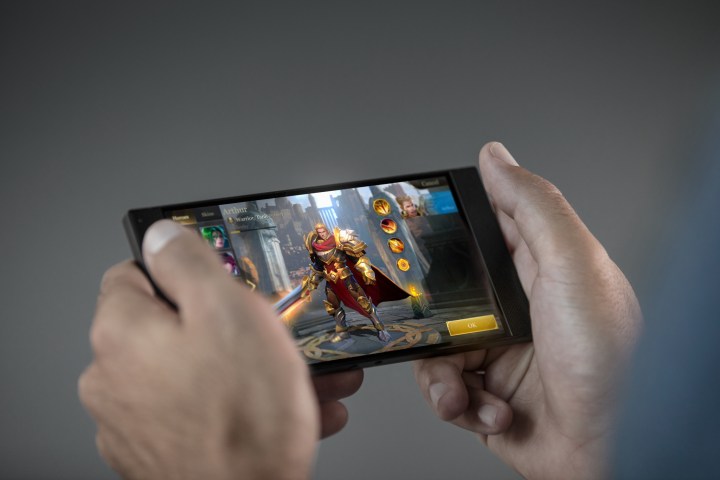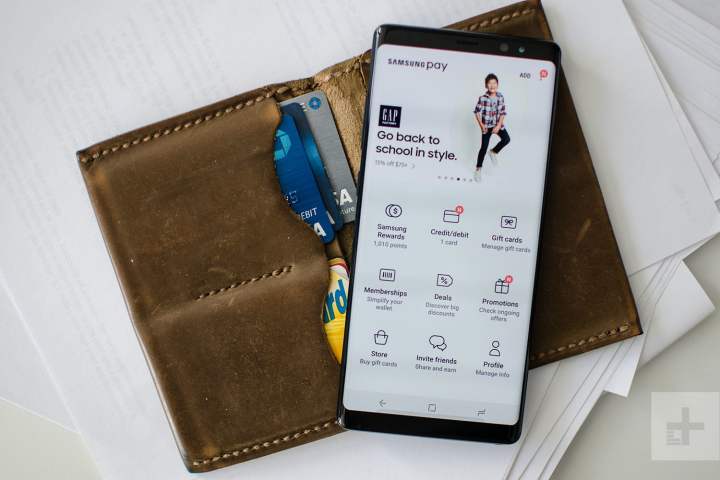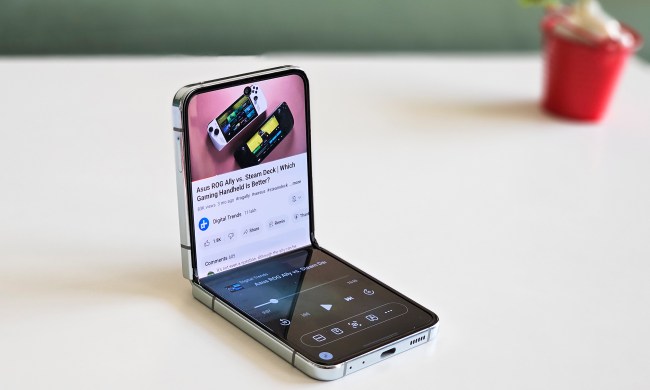
But how does the Razer Phone stack up against the biggest boys on the block? We’ve put the Razer Phone to the test, sending it up against Samsung’s premiere pit fighter, the Galaxy Note 8, in a six-round slobberknocker deluxe.
Specs
Galaxy Note 8 |
Razer Phone |
|
| Size | 162.5 x 74.8 x 8.6 mm (6.40 x 2.95 x 0.34 inches) | 158.5 x 77.7 x 8 mm (6.24 x 3.06 x 0.31 inches) |
| Weight | 195 grams (6.88 ounces) | 197 grams (6.95 ounces) |
| Screen | 6.3-inch Super AMOLED | 5.72-inch 120 Hz Ultramotion LCD display |
| Resolution | 2960 × 1440 pixels (522 ppi) | 2560 x 1440 pixels (514 ppi) |
| OS | Android 7.1.1 Nougat | Android 7.1.1 Nougat |
| Storage | 64GB, 128GB, 256GB | 64GB |
| MicroSD card slot | Yes | Yes |
| NFC support | Yes | Yes |
| Processor | Qualcomm Snapdragon 835 (U.S.), Samsung Exynos 8895 (international) | Snapdragon 835 with Adreno 540 |
| RAM | 6GB | 8GB |
| Connectivity | LTE, GSM, CDMA, HSPA, EVDO, 802.11a/b/g/n/ac Wi-Fi | GSM, UMTS, HSPA, TD-SCDMA, LTE, TDD LTE, 802.11 a/b/g/n/ac Wi-Fi |
| Camera | Dual 12 MP rear (both with OIS), 8MP front | Dual 12 MP rear (f/1.75 wide angle & f/2.6 zoom), 8 MP front |
| Video | Up to 4K at 30 fps, 1080p at 60 fps, 720p at 240 fps | Up to 4K at 30 fps. |
| Bluetooth | Yes, version 5.0 | Yes, version 4.2 |
| Fingerprint sensor | Yes | Yes |
| Other sensors | Accelerometer, barometer, gyro, geomagnetic, heart rate, proximity, iris, pressure | Accelerometer, gyro, proximity, compass |
| Water resistant | Yes, IP68 rated | No |
| Battery | 3,300mAh
22 hours of talk time, 13 hours of internet, 16 hours of video playback, and up to 74 hours of audio playback Fast charging, wireless charging (Qi standard) |
4,000mAh
Qualcomm QuickCharge 4.0+ |
| Charging port | USB-C | USB-C |
| Marketplace | Google Play Store | Google Play Store |
| Colors | Midnight Black, Orchid Gray | Black |
| Availability | AT&T, Verizon, Sprint, T-Mobile, Unlocked | Razer |
| Price | $930 | $700 |
| DT review | 4 out of 5 stars | Hands-on review |
In terms of pure internal specifications, we’re looking at two similar phones. Both the Razer Phone and the Galaxy Note 8 are using the Snapdragon 835 processor, as is common for 2017 flagships. The Razer Phone has an edge in RAM, with 8GB compared to the Note 8’s 6GB, but the impact of RAM on day-to-day usage is arguable. If you really love to multitask, then the extra 2GB might be a draw.
It’s a similar story in storage options. The Razer Phone offers 64GB of storage, equaling Samsung’s Note 8 (although international versions come with 128GB and 256GB). Both phones also support MicroSD cards for storage expansion, with the Razer Phone offering up to a staggering 2TB in extra storage through a MicroSD card, trumping the Note 8’s 256GB restriction.
There are some real differences when we move to audio features. The Razer Phone has forgone the inclusion of a 3.5mm headphone port — a feature that you’ll still find on the Note 8. To make matters worse, the latest Bluetooth 5.0 isn’t available in the Razer Phone, just the older Bluetooth 4.2. The Note 8 comes with Bluetooth 5.0, despite also having a headphone jack. Since the Razer Phone is going to rely on USB-C headphones (and a dongle) or wireless connections for personal music, we would have liked to see the improved range, strength, and features that Bluetooth 5.0 offers.
Razer does pull some points back for the speakers. While the Note 8’s speaker is decent enough, it can’t hold a candle to Razer’s set of dual front-facing speakers. We’re expecting some great performance out of those, and the Razer Phone should be a go-to for media sharing.
Despite the inclusion of the same processor, extra RAM, and that awesome-looking set of front-facing speakers, the Razer Phone finds it hard to win against the Note 8’s headphone port, and upgraded Bluetooth 5.0. The Galaxy Note 8 wins here — narrowly.
Winner: Galaxy Note 8
Design and display

You’d be hard pressed to confuse these two phones. The Note 8 is a bezel-less beauty, with a 6.3-inch Super AMOLED display taking up the majority of the front, with only a slim chin and forehead containing the front-facing camera and sensor suite. In contrast, the Razer Phone is far from bezel-less with a sizeable forehead and chin housing the aforementioned front-firing speakers. Despite that, it’s not a bad looking phone. The angular sides remind us of a Sony Xperia, and the 5.7-inch screen still dominates the front. It’s a design that you’ll either love or hate — the Razer Phone celebrates an angular aluminum design that contrasts heavily with the smooth curves and sleek glass on the Note 8.
It’s the display that will be the real draw for the Razer Phone. While the LCD screen won’t be capable of the color saturation and deep blacks you’ll find on the Note 8’s Super AMOLED panel, the Razer Phone boasts a 120Hz Ultramotion screen that’ll provide extremely smooth gaming on the go, and give a boost to VR. While it’s not the first device to offer this high level of refresh rate, it’s not a common feature, and proponents say that it provides a much smoother experience over the more usual 60Hz displays.
Durability-wise, the Note 8 is a beautiful behemoth of glass and metal, and comes with the worries that you’d expect from such. As always, we recommend a case for peace of mind. The Razer Phone won’t have any such worries, since the body of the phone is made from aluminum. While the Razer Phone comes with older Gorilla Glass 3 (compared to the newer Gorilla Glass 5 on the Note 8), it only needs glass coverage on the flat screen.
In terms of waterproofing, the Note 8 comes with IP68 resistance, meaning it should be able to take exposure in up to 5 feet of water for up to 30 minutes with few adverse affects (though we don’t recommend testing that). The Razer Phone comes with no water resistance at all, so keep a strong handle on this phone at all times around anything even slightly wet.
This category has a clear winner. While the Razer Phone wows with its 120Hz Ultramotion display, and we have a certain soft spot for its angular design, it simply can’t compete against the pure elegance of the Note 8’s curved glass build, incredible Super AMOLED screen, and waterproofing features.
Winner: Galaxy Note 8
Camera

Both phones are rocking the latest dual camera trends, and amusingly, use 12 megapixel sensors for both of their lenses. The Note 8’s camera is a proven beauty, scoring a 94 on DxOMark’s rigorous camera tests, and earning a spot on our best smartphone camera list for its outstanding low-light performance. Peer a little deeper into the Note 8’s cameras and you’re looking at an f/1.7-aperture wide-angle lens and an f/2.4-aperture telephoto lens. Optical image stabilization (OIS) keeps your shots steady, even when using the 2x optical zoom function, and the phone is capable of a DSLR-style “bokeh” effect by using both lenses to keep a subject in focus, while applying a soft blur to the background.
We’re yet to spend any quality time with the Razor Phone’s cameras, but the hardware seems solid at an initial glance. Like the Note 8, we’re looking at two 12 megapixel lenses, with a wide-angle and a zoom lens side by side, though the aperture sizes are slightly different to the Note 8 — f/1.75 and f/2.6 respectively. These sorts of stats should provide solid camera performance, and we’re expecting good things from the Razer Phone.
Switching over to video, you’ll get 4K at 30 frames per second (fps) from the Note 8, as well as a supersmooth 60 fps on video shot at 1080p. If you’re watching something particularly impressive, you can slow the action down with 240 fps slow motion video — though you’ll need to drop to 720p for this. In contrast, the Razer Phone can also shoot 4K at 30 fps, but we’re not expecting any slow motion trickery from higher fps videos.
The front-facing cameras on both are pretty standard 8 megapixel lenses that should provide good selfie shots. The Note 8 has something of an edge here, thanks to the suite of extra fun effects you can add to your selfies, including Snapchat-style filters. To date, we haven’t seen anything like that from the Razer Phone.
It’s tough to make a call in this category. However, in lieu of quality time with the Razer Phone, we have to give it to the Galaxy Note 8’s proven cameras. We’re expecting good things from the Razer Phone, but we’re not sure it’ll quite manage to topple Samsung’s strong record in photography. We’ll update this if the Razer Phone’s camera does turn out to be a Note 8-beater.
Winner: Galaxy Note 8
Battery life and charging

With a 3,300mAh battery, the Note 8 was good enough to make it through the day pretty easily, ending with around 30-percent battery at 6 p.m. after a day of medium to heavy usage. With that in mind, we’re also expecting good things from the Razer Phone’s 4,000mAh battery. While it’s not all about numbers, and software optimizations can help make a smartphone more energy efficient, we’re pretty confident that the Razer Phone is going to have beefy battery life with plenty in the tank for hours of gaming.
The Note 8 benefits from fast charging, being capable of charging from 40 percent to 92 percent in under half an hour. The Razer Phone will be the first phone to come with Qualcomm’s new QuickCharge 4.0+, with promises of five hours of power from five minutes of charge. If the Razer Phone can fully deliver this radically fast charging, then Razer Phone users are likely to be spending even less time tethered to their charger — though Samsung Note 8 users will have the option of wirelessly charging their phone, which the Razor Phone lacks, thanks to the aluminum body.
It’s another exceptionally close race here, and each phone has its own strengths and weaknesses. But we’re suckers for a larger battery. Wireless charging is great, but a longer battery life trumps the ability to charge wirelessly. The Razer Phone takes this round.
Winner: Razer Phone
Software
Stock Android-heads beware! Boot up either of these phones and you’ll be looking at a modified version of Android 7.1.1 Nougat. The Note 8 comes with Samsung’s altered version of Android, the Samsung Experience, while the Razer Phone is using acclaimed third-party Android launcher, Nova Launcher.
The Samsung Experience on the Note 8 serves up Samsung’s latest version of the Android platform, and comes with a host of useful options for the user. Top of the list (certainly in Samsung’s book) is Bixby — Samsung’s in-house personal AI assistant. In practice, it’s actually pretty useful, bringing up lists of information it thinks might be useful, and executing various simple voice commands. Performance on the Note 8 is supersmooth, the only black mark being the consistently slow launch of Bixby Home.
If the Samsung Experience is Samsung’s attempt at tailoring the Note 8 to your specific needs, than Nova Launcher is the perfect way to set your phone up exactly how you want it. We don’t know a huge amount about the specific Nova Launcher used on the Razer Phone, but from our own use of Nova Launcher, we know that it’s an incredibly customizable interface, with options for changing your app drawer, animation types for swapping between windows, unique gestures to open apps, and tons more features. It’s a great little piece of software that runs smoothly on a variety of devices, and with Android 7.1.1 Nougat running underneath, it also comes with all the latest innovations from Google.
However, the Note 8 has the S Pen. Samsung’s awesome stylus brings a whole new angle to the Samsung Experience, letting users write notes on their Always On display, doodle pictures for friends, capture GIFs and screenshots at the touch of a button, magnify the screen, and loads more. The Razer Phone was always going to have a hard time beating the extra tools that Samsung Experience brings to the table — and with the addition of the S Pen, it’s clear that the Note 8 comes out the stronger.
Winner: Galaxy Note 8
Price and availability

The Note 8 is available from multiple vendors in the United States, including AT&T, T-Mobile, and Sprint. However, pricing for it starts at an eye-watering $930 for 64GB of storage. That sort of price is very difficult to justify when the Razer Phone starts at $700 for the same amount of storage. With that said, we’re not sure about availability for the Razer Phone, with no carriers having announced that they’ll be taking on Razer’s new beast. And with a lack of banding for CDMA, you’re restricted as to which carriers you’ll be able to take an unlocked Razer Phone onto.
This is tough to call — the Note 8’s high price versus the restrictions on the Razer Phone. We’re going to give the Razer Phone the win here since its $230 cheaper, but Verizon or Sprint customers will want to look elsewhere.
Winner: Razer Phone
Overall winner: Galaxy Note 8
Let’s get real — it could only ever have been this way. The Note 8 is Samsung’s frontline soldier in the war against Google for dominance of the highest-end Android marketplace, and it’s packed to the brim with the latest gizmos, bells, whistles, and everything else that Samsung could cram into its tiny frame. It’s a triumph of design and execution, with power in droves, design to die for, and the brilliant S Pen.
That said, the Razer Phone put up an exceptionally tough fight, and this loss shouldn’t be taken as a reason not to buy it. Coming in more than $200 cheaper, it’s still a great choice and boasts a Snapdragon 835 processor, more RAM than you’ll likely ever need, and that incredible 120 Hz Ultramotion display. We’re expecting great things from the Razer Phone when we properly get our hands on it, and even if it’s not capable of standing up to the Galaxy Note 8, that’s no slur on its performance.




